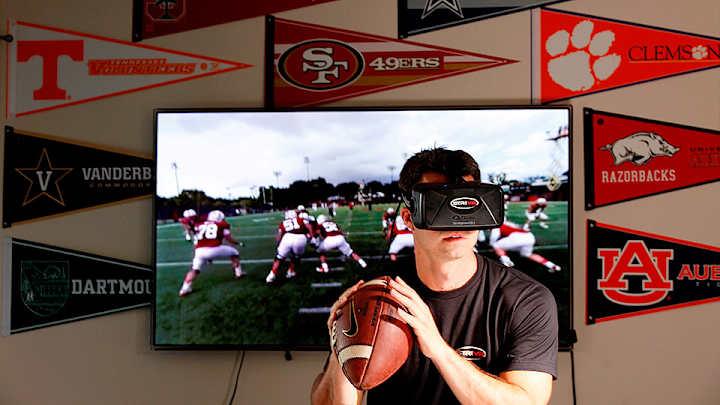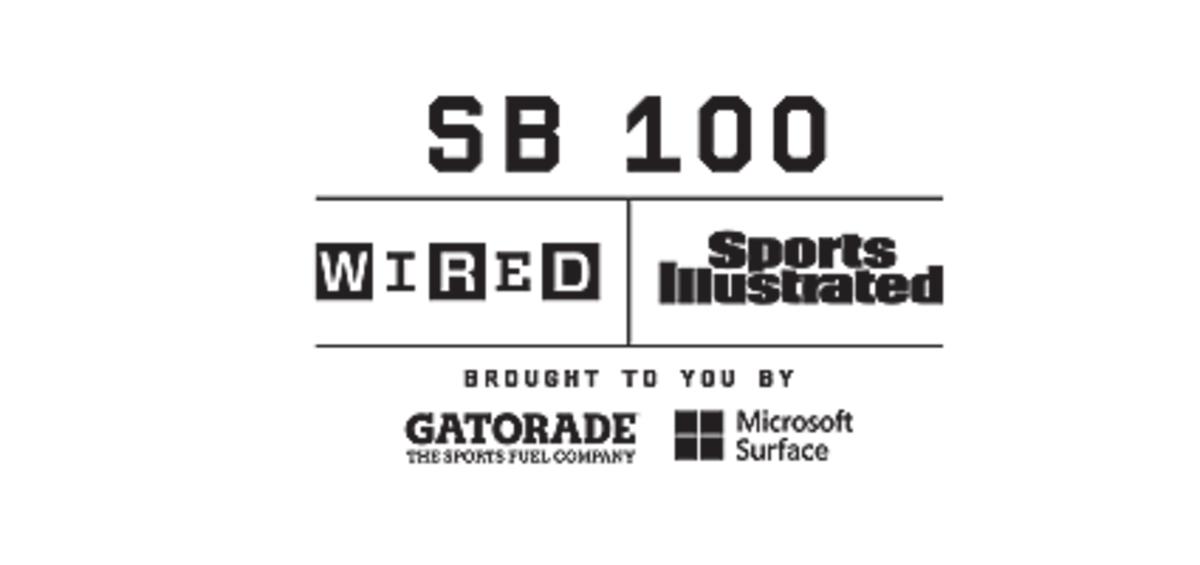Examining the future of virtual reality and the impact it will have on football

PALO ALTO, Calif. — Derek Belch isn’t one for bold predictions. The co-founder of STRIVR Labs, a Stanford-based virtual reality company that has exploded in popularity since debuting at the NFL combine last February, says that it’s ironic he’s in charge of a technology business, because he doesn’t even like technology that much.
So it’s tough to get him to look into the future and imagine how virtual reality will grow, change and continue to intersect with football in the next 50 years. Part of that, he says, is because VR is already growing and changing at an exponential rate, with new data and content available on a daily basis.
“We talk about certain things and they sound really far away,” says Belch, a former graduate assistant with the Stanford football team who left coaching in January 2015 to immerse himself in VR. “But in reality, some of those things are three years out.”
Like what? It’s a longer list than you'd imagine—and not all of it is quarterback-related.
Yes, Arizona Cardinals quarterback Carson Palmer—the team is a STRIVR client—can gain tremendous knowledge from snapping on a headset and taking mental reps. In November, Palmer raved about Arizona’s use of VR to The MMQB’s Peter King, saying, “It’s phenomenal. I don’t buy in to all the new technology, but I am all in on this.” He then detailed how STRIVR has helped him review and improve his mechanics, adding that the content is so realistic, he’ll sometimes have “flashbacks” to games.
But this off-season, as Belch and STRIVR work to expand their client list (six NFL teams used STRIVR during the 2015 season), Belch will emphasize that VR is not just limited to quarterbacks.
NFL Films embraces digital cameras to keep nostalgia alive
Imagine one of Palmer’s offensive linemen putting on a headset to study an opponent’s defensive line and memorizing moves a defensive end makes when he’s trying to sack Palmer? It sounds far out, but Belch says they’re already doing it.
Belch and the STRIVR staff are also focused on building a “sweet library catalogue” for each of their clients that every player and position group can learn from. They’re also hoping for improvements in software—stitching together images is a complex process that STRIVR has streamlined, but it can always get better and easier—and content capture. Cameras are changing and shrinking rapidly, making them less intrusive, but gathering content isn’t as simple as strapping a camera on a helmet (too shaky and too bulky) or a drone (too unpredictable) and downloading the footage.
“Drones can have a mind of their own,” Belch says. “If it one of them crashed into a left tackle, we’re in trouble.”
There’s also progress to be made in the content itself. Right now, if Palmer or any other NFL player puts on a headset to relive a practice, he gets a 360-degree view and experience. But he can’t move within that virtual environment; “walking” forward, for example, wouldn’t work, because camera spacial relations would get screwy. (In gaming technology, with avatars, it is possible to walk around.) But at the rate VR is growing—in technology, popularity and in investors’ willingness to spend big bucks—that’s likely possible sooner rather than later.
“Right now, putting actual game film into VR is not possible,” Belch says. “But in 50 years, yeah, it’s probably going to happen.”
Tim Tubito, in his 12th season as director of video for the New York Jets (a STRIVR client), says that three years ago, he read Infinite Reality: The Hidden Blueprint of our Lives, and reached out to Jeremy Bailenson, the book’s author. Bailenson, a co-founder of STRIVR, is a Stanford communications professor who has studied VR since the late 1990s, and he's made a point of how quickly things are progressing.
“I have seen more change in technology in the past two years than I have in the previous 18 combined,” says Bailenson.
Roundtable: What will media coverage of Super Bowl look like in 50 years?
He and Tubito have had numerous conversations about the practical applications of VR, and Tubito’s had a front row seat to VR’s growth. Three years ago there were plenty of ideas, but no ways to execute those ideas. Now, Jets players regularly use VR.
“When I started, I never thought tape and film would go away,” Tubito says. “Now we do almost everything on hard drive. Technology seems to be taking on a life of its own. I would never limit where I see (VR) going. It’s going to change how people prepare for games, how they look at games and eventually, how fans consume the game.”
Look for new entries in the Super Bowl 100 series, presented by Gatorade and Microsoft Surface, at SI.com/SB100 and Wired.com/SB100
Chapter 1, Oct. 7 TRAINING
Chapter 2, Oct. 28 EQUIPMENT
Chapter 3, Nov. 18 STADIUMS
Chapter 4, Dec. 9 CONCUSSIONS
Chapter 5, Dec. 16 MEDIA
Chapter 6, Dec. 30 VR
Chapter 7, Jan. 6 NFL IN SOCIETY
Chapter 8, Jan. 13 TRACKING
Chapter 9, Jan. 20 STRATEGY
Chapter 10, Jan. 27 SB 100
ROAD MAP TO
THE FUTURE
Andrew Wasserman, a STRIVR vice president of product and a former North Carolina receiver, says that while there’s rapid growth within the industry, “lots of venture capitalists aren’t touching it, because they want VR to prove itself.” In other words, it needs to be more than a fad. One unknown is if a camera could ever fully capture every tiny human nuance needed to completely form a virtual environment.
Then again, 50 years ago, did it seem realistic that everyone would walk around with a small computer in their pocket or purse?
Belch, a former Stanford kicker, says it’s ridiculous to think that a VR headset, complete with every look in an NFL team’s playbook, could one day be all a player needs to succeed in the pros. “I don’t think we’re ever going to replace practice—and that would be sad, if we did. No video can ever take the place of learning what it’s like to actually tackle someone or be tackled. But what we’ve done is solve a problem: There’s not enough time for everyone to get reps. This can help with that.”
Given the emphasis on experiential mediums, there could also come a day when fans who don’t want to deal with the hassle of traveling to and from a game sit on their couch and, instead of turning on the TV, strap on a headset. That comes with a different set of headaches, because any professional or college league will want to “monetize those eyeballs,” Belch says.
At the Stanford Virtual Human Interaction Lab, where Belch first started toying with the idea of STRIVR, Bailenson and his staff try to determine how VR can change thoughts and interactions, with a focus on emotion, not innovation. Subjects are put through earthquake simulations, explore a coral reef or embody a superhero, among other experiences. Student programmers build studies, and collect behavioral and physiological data. The lab does a lot of work “becoming someone else,” Bailenson says. In July, NFL commissioner Roger Goodell scheduled a visit to Stanford to explore how Bailenson can “help (NFL) players learn what it’s like to be a child, or a woman in a marriage, and behave properly.”
VR has already been used for general education (like a fifth grade class taking a virtual field trip to China) military training and phobia desensitization. In a tour of the Stanford lab in late November, a visitor wondered aloud if there would come a day when VR would be used in a clinic setting: Maybe a doctor could prescribe 10 sessions of VR, for example, to help a patient with a paralyzing fear of spiders.
How will NFL improve concussion problem over the next 50 years?
After that tour, lab project manager Elise Ogle said there’s a long list of questions that arise as VR becomes more mainstream, including how to regulate VR and the ethical ramifications of putting someone in an unsettling experience. In the immediate future, Ogle believes VR headsets will continue to get cheaper, smaller and better. A few years ago, the Stanford lab’s virtual reality headset cost $40,000, weighed 51 pounds and had a screen that sat five inches from a viewer’s face. Now, headsets retail for about $200 apiece, and can connect with most smartphones. Ogle points out that studies are still needed on the feasibility of viewers wearing headsets for longer than 15 minutes. “Remember when your parents would say to you, ‘Don’t sit too close to the TV’? Well, what will wearing a headset do to us? We’re still not sure.”
Not sure. That seems to be the answer when anyone examines the future intersection of football and virtual reality. Belch loves that “so many people are getting into” VR because he sees it as a tangible, valuable product that can be consumed by the masses, much like the NFL. Teams aren’t sure what will happen in 50 years either, though it’s realistic to assume more franchises will invest. What VR will be able to be used for, though, is an ever-growing list of possibilities.
“Predicting in the far future, one should think about biology replacing hardware as an interface,” says Bailenson. “Instead of using ‘controllers,’ people wil simply connect their thoughts and impulses directly into the simulation. In the future, VR will not require any gadgets. It will simply be an experience.”
And what about the nearer future?
“Even in five years, it’s hard to predict where (VR) will go,” says Tubito, the Jets director of video. “It’ll only move as fast as the technology takes it …
“But this is only the beginning.”

